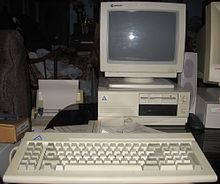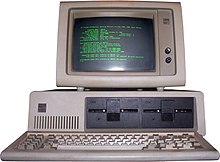IBM PC Compatible Computer



Historically speaking, personal computers or microcomputers that were based on the technical design of the IBM PC from 1981 and its successor models such as the IBM PC / AT were referred to as IBM-PC-compatible computers or IBM-compatible PCs . More rarely, the replicas were also referred to as IBM replicas (or clones), as they were actually technically largely identical copies, especially in the early years. Later, the term IBM-compatible was used less often and much more generally for systems that emulate a microprocessor of the x86 type and start a corresponding BIOS . The latter is being replaced by the more modern EFI .
IBM PC-compatible computers were also referred to as PCs for short , as a platform to distinguish them from Apple Macintosh models, the Atari ST series and others. However, since the term personal computer was used early on for platforms other than x86-based, this designation was not always clear. Due to the massive spread of compatible x86 PCs from other manufacturers, the importance of IBM as the initial market leader declined sharply in the 1980s. In 1987, IBM brought the newly developed PS / 2 series onto the market, which completely broke with the previous PC concept and introduced proprietary technologies such as the microchannel bus system that were deliberately no longer freely available to other manufacturers.
As a result, the PCs from IBM themselves were paradoxically no longer IBM PC compatible, with which IBM undermined the industry standard it had set itself . However, this was an economic failure, because large PC manufacturers such as Compaq did not make this swing. Instead, they successfully set their own technical standards such as the EISA bus to compete with the microchannel concept. With the sale of its PC division to Lenovo in 2005, IBM finally withdrew completely from the PC division.
For these reasons, the term IBM-PC-compatible is outdated and also technically incorrect since the PS / 2 line, which is why it is hardly used anymore. Current terms for x86-based computers are mainly the terms PC, Windows PC or Windows computer, after the dominant operating system , or, less often, Wintel computer as an artificial word from Windows and Intel , the market-leading x86 processor manufacturer.
history
Since the IBM PC - in contrast to its competing products at the time - was built exclusively with commercially available standard components , this led to numerous replicas. The IBM PC developed into an unofficial industry standard because it could be recreated from IBM without licensing . At IBM itself, such imitations were somewhat belittlingly referred to as IBM PC compatible .
With the introduction of new processors from i286 and all later models with 32-bit word length, the chip manufacturer Intel integrated a (virtual) 8086 on the chip so that x86-compatible computers could still be built. In order to keep the power consumption of today's chips as low as possible, the 8086 functionality is now emulated by firmware integrated in the processor . Depending on the manufacturer and CPU, the microcodes used for emulation have names such as ROP, Micro-Op or µOp.
future
If the EFI does not provide BIOS compatibility, a computer without the IBM-compatible BIOS is no longer to be understood as IBM-compatible in the "narrower sense". Only an IBM-compatible BIOS enables an IBM-PC-compatible DOS operating system to be started, and thus in principle the possibility of using the respective computer exactly like an IBM PC from 1981. The DOS operating systems require the motherboard-specific BIOS as a hardware abstraction layer for accessing the resources of the motherboard and standardized expansion cards known to the BIOS. This means that DOS operating systems cannot start without an IBM-compatible BIOS and programs for the IBM PC can no longer be executed natively on the respective system. A computer without an IBM compatible BIOS is therefore essentially not IBM compatible.
Hardware access must be coordinated under modern operating systems with multitasking capabilities. This takes place here, bypassing the BIOS, directly via the device drivers; the BIOS is only required when the operating system is booted.
For this reason, over the years the BIOS has also been freed from ballast that was felt to be superfluous. As early as the 1980s, numerous PC manufacturers dispensed with the ROM-Basic, which was available on the original IBM PC and which the IBM PC started when it did not find a floppy disk with an operating system. An implementation would have required additional effort and possibly the permission of IBM. The hardware abstraction interface for the datasette port also disappeared relatively quickly from the BIOS codes of the PC clone manufacturers due to lack of use. In today's PC motherboards with BIOS, the floppy interface has also been saved or severely restricted on the BIOS side; often only one drive can be configured. The support of older floppy drive types by current BIOS variants is also questionable.
Strictly speaking, these systems are therefore only partially compatible with IBM PCs , since the original IBM PC, for example, provided for the connection of Datasette and several 5.25 "floppy drives on both the hardware and the software side, what modern computers no longer offer, as hardware and operating systems have evolved. The PC architecture has been continuously adapted to these developments by adding and leaving out elements over the years. Therefore, it can be stated that the degree of compatibility with the IBM- PC in part as early as the 1980s, but also after the replacement of DOS by Windows 95 with the accompanying dwindling importance of the BIOS.
The core element of an IBM PC-compatible computer has remained an x86-compatible main processor over the years, which starts a BIOS, which essentially still has the functionality of the BIOS of the original IBM PC, adapted to the requirements of modern hardware and software , depicts. As a result, it is basically still possible to use DOS operating systems on modern systems and thus also numerous programs for the original IBM PC, so that the compatibility of modern systems with their "ancestors" is still given and can be regarded as high.
In the medium term, however, a further decrease in this compatibility level is to be expected, since many classic BIOS functions are in less and less demand. With the BIOS successor EFI, a definitive end to the era of “IBM PC-compatible computers” is in sight, even if EFIs with BIOS-compatible functions for older operating systems may still be implemented at the beginning. However, it is to be expected that these residual functions will then also be requested less and less by software and will gradually disappear from the firmware. With EFI and Microsoft's announcement that Windows 8 will also be able to use EFI instead of a BIOS for starting the operating system, the slow end of the BIOS and thus of the IBM PC-compatible computer has finally heralded.
Since modern operating systems are abstracting more and more hardware internals in various “layers” and through set up runtime environments , the significance of these changes, which take place on the lower levels, is hardly relevant nowadays. Today, the operating systems can be operated with different firmwares or loaders, often with very different hardware architectures such as B. bypass ARM SoCs . The term “IBM-PC compatible computer” starts at a level that is only of interest to a few users today and is therefore rarely used. Of interest to users today is the question of compatibility with certain operating systems, which today - for example in the case of Windows - usually includes compatibility with IBM PCs.
Interfaces

In order for the operating systems available for IBM PC-compatible computers to work together with different hardware extensions, in addition to the x86-compatible processor, standardized interfaces are also required. The original PC had internal 8-bit ISA slots as well as a connection for up to two floppy drives. External there were serial and parallel interfaces and a keyboard connection, as well as a digital MDA monitor connection for monochrome text displays. However, these interfaces were expanded and modernized in the course of development.
See also :
- Peripheral Component Interconnect (PCI)
- PCI Express (PCIe)
- Accelerated Graphics Port (AGP) (obsolete, no longer being built)
- Industry Standard Architecture (ISA) 8-bit or 16-bit (outdated, no longer being built)
- Extended Industry Standard Architecture (EISA) (outdated, no longer being built)
- VESA Local Bus (VLB) (obsolete, no longer being built)
- Universal Serial Bus (USB)
- FireWire (IEEE1394)
- PCMCIA (obsolete, no longer being built)
- PC card
- ATA / ATAPI , also IDE (outdated)
- Serial ATA (SATA)
- PS / 2 interface (obsolete)
- Parallel port (obsolete)
- Serial interface , also RS232 interface (outdated, today only for special applications)
- VGA connection (obsolete)
- Digital Visual Interface (DVI)
- High Definition Multimedia Interface (HDMI)
Some of these interfaces are also used by other hardware. Use of connected extensions may require However, the availability of appropriate drivers may be required.
Operating systems
Almost all operating systems are available for IBM PC-compatible computers . The most common were or are:
- PC-compatible DOS , these are DOS operating systems for IBM PC-compatible computers (PC DOS, MS-DOS, DR DOS and many more)
- Windows (both Windows 9x and Windows NT )
- OS / 2 (as well as its further developments eComStation and ArcaOS)
- Unix or various Unix derivatives for x86: u. a. Xenix , * BSD from 386BSD ( e.g. FreeBSD ), Linux (with ELKS also for 8086) or Darwin ( Rhapsody , but not macOS )
- ZETA (further development of BeOS ) or Haiku
and much more
See also
- Downward compatible processor architectures
- x86 processor (16-bit from 8086/8088, 32-bit from i386, 64-bit from Opteron)
- Standard housing
Web links
Individual evidence
- ↑ heise online: 30 years ago: IBM goes on the PS / 2 and OS / 2 offensive. Retrieved April 16, 2020 .
- ↑ Compute! Magazine Issue 103 . December 1988 ( archive.org [accessed April 16, 2020]).
- ↑ Deni Connor: Micro Channel vs. EISA and PCI. October 26, 2007, accessed April 16, 2020 .
- ↑ What is WinTel? - Definition from Techopedia. Retrieved April 16, 2020 .
- ↑ INTEL 286. Retrieved April 16, 2020 .
